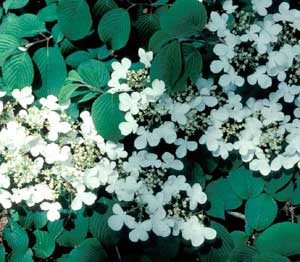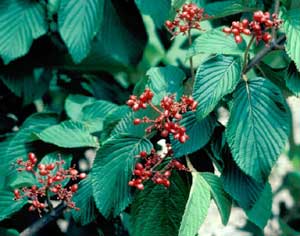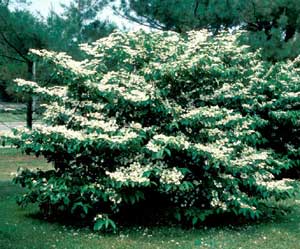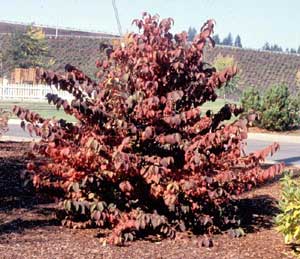Landscape Shrubs
Doublefile Viburnum
(Viburnum placatum var. tomentosum)
The doublefile viburnum plant makes a great strange-but-true story or a good trick question in a plant materials class. By normal logic, the Japanese snowball viburnum (Viburnum plicatum) and the doublefile viburnum (Viburnum plicatum var. tomentosum) are backwards. For a plant to be recognized as a species, it must capable of reproducing by seed. Since the snowball viburnum has sterile flowers and therefore does not produce seed, and yet the doublefile does produce viable seed, it would make more sense that doublefile would be the species and snowball the variety.
Either way, these plants thrive in Arkansas. They are large deciduous shrubs that provide multi-season interest. In Arkansas, flowers appear in mid- to late April. The doublefile flowers are born on a 4-6” diameter flat-topped cyme. The inner circle of fertile flowers (will develop into fruit) are not showy, while the outer ring of sterile flowers, which look like popcorn, are very attractive. The Japanese snowball viburnum flowers are sterile, which gives the rounded inflorescence a snowball-like appearance. A healthy snowball in full flower is so showy that it is almost grotesque.
(There is another viburnum that bears the ‘snowball’ name—the European snowball viburnum (Vib. opulus ‘Roseum’). The European variety has three major lobes to the leaf, like a red maple, and blooms for about two weeks. The European snowball is very common in the Midwest. )
In June and into July, beautiful deep red stalks develop small red fruits that birds love to eat. Inconsistent fruit-set may be an issue with doublefile viburnum. In the fall, the doublefile stalk turns either a light red or deep maroon and leaves turn dark green.
Doublefile and snowball are considered large shrubs. Mature plants grow about 8-12’ tall and wide. Most plants are easy to identify from a distance by the characteristic layered branching. Besides an occasional stem dieback, they have no significant disease or insect problems. In central Arkansas, the plant should be located in partial shade, but will tolerate full sun if you provide adequate water in July and August. Avoid locations with poorly drained or heavy soils.
Several cultivars of doublefile include ‘Lanarth,’ ‘Mariesii,’ and ‘Shasta.’ ‘Shasta’ is an exceptional introduction from the U.S. National Arboretum that is very floriferous. ‘Shoshoni’ is a smaller-sized seedling of ‘Shasta.’ The literature indicates its mature size at 5’x 8’. ‘Summer Snowflake,’ as the name suggests, spits out a few flowers all summer long.
Either way, you can’t go wrong with the Japanese snowball viburnum or the doublefile. Both are great large shrubs for your landscape.
- Common Name: doublefile viburnum
- Varieties to look for: ‘Lanarth,’ ‘Mariesii,’ and ‘Shasta’
- Flower Color: white
- Blooming period: mid- to late April
- Type: deciduous shrub
- Size: large; 10’ tall x 10’ wide
- Exposure: full sun
- Soil: adaptable
- Watering: moist best
- When to prune: after flowering
- Suggested use: mixed shrub border, corner of foundation
Flower

Fruit and leaves

Form

Form in fall color
